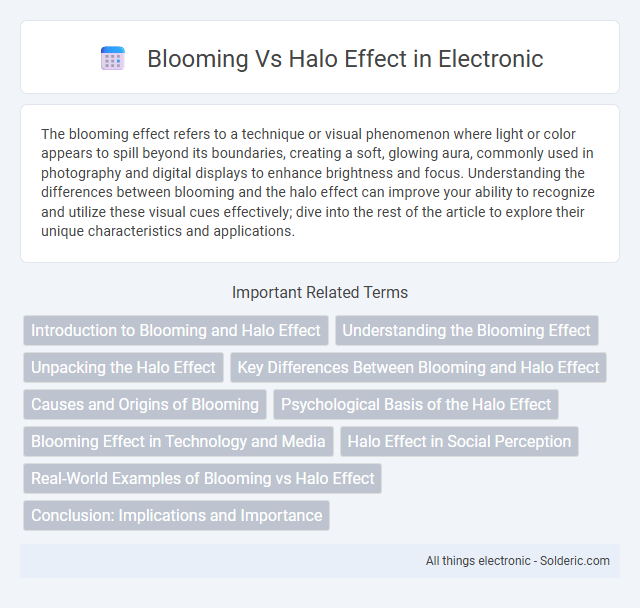The blooming effect refers to a technique or visual phenomenon where light or color appears to spill beyond its boundaries, creating a soft, glowing aura, commonly used in photography and digital displays to enhance brightness and focus. Understanding the differences between blooming and the halo effect can improve your ability to recognize and utilize these visual cues effectively; dive into the rest of the article to explore their unique characteristics and applications.
Comparison Table
| Aspect | Blooming Effect | Halo Effect |
|---|---|---|
| Definition | Positive growth or improvement in skills, performance, or appearance over time. | Cognitive bias where overall impression influences specific judgments about a person or object. |
| Scope | Actual development and progress. | Subjective perception influencing unrelated traits. |
| Occurrence | Occurs naturally through experience, learning, or maturation. | Occurs instantly based on initial impressions. |
| Impact | Leads to genuine improvement and positive outcomes. | Can cause biased evaluations and inaccurate assessments. |
| Example | An employee's skills improving after training sessions. | Assuming someone is competent because they are physically attractive. |
| Field | Psychology, personal development. | Social psychology, cognitive biases. |
Introduction to Blooming and Halo Effect
The Blooming Effect refers to the phenomenon where initial positive impressions or achievements lead to continued success and growth in an individual's performance or perception. The Halo Effect occurs when a single positive trait or characteristic of a person influences overall judgments, causing you to perceive unrelated qualities more favorably. Understanding these cognitive biases helps in making more objective decisions and evaluations in personal and professional contexts.
Understanding the Blooming Effect
The Blooming Effect refers to the phenomenon where initial positive impressions or early success lead to increased confidence, motivation, and ultimately enhanced performance over time. This effect highlights how positive reinforcement and growth opportunities contribute to an individual's or organization's development trajectory. Understanding the Blooming Effect is crucial for leveraging early achievements to sustain long-term success and continuous improvement.
Unpacking the Halo Effect
The Halo Effect, a cognitive bias where one positive trait influences overall perception, often skews evaluations in personal and professional settings. Unlike Blooming, which involves gradual development and growth over time, the Halo Effect creates immediate judgments based on limited information. Understanding this bias helps you make more objective decisions by separating individual qualities from overall impressions.
Key Differences Between Blooming and Halo Effect
The key differences between blooming and halo effects lie in their psychological impact and context of occurrence: blooming effect refers to the rapid improvement or growth in a person's skills or characteristics over time due to positive reinforcement, whereas the halo effect is a cognitive bias where the perception of one positive trait influences the overall judgment of a person. Blooming is often observed in developmental or educational settings, highlighting genuine progress, while the halo effect skews objective evaluation by generalizing from a single favorable attribute. Understanding these distinctions aids in accurately assessing behavior and performance without cognitive distortion.
Causes and Origins of Blooming
The blooming effect originates from positive reinforcement cycles where initial success boosts confidence, leading to improved performance and further achievements. It is often caused by enhanced motivation, increased effort, and favorable feedback that amplify an individual's capabilities over time. Environmental factors such as supportive mentorship and resource availability also contribute significantly to the development of blooming.
Psychological Basis of the Halo Effect
The psychological basis of the Halo Effect lies in cognitive bias, where Your overall impression of a person, often influenced by one positive trait, shapes judgments about unrelated characteristics. This mental shortcut simplifies decision-making but can lead to inaccurate evaluations by overshadowing specific details. Understanding this bias helps in making more objective assessments and avoiding the misleading influence of first impressions.
Blooming Effect in Technology and Media
The Blooming Effect in technology and media refers to the rapid and exponential growth of new innovations and platforms, often driven by user engagement and viral content. This phenomenon accelerates the adoption of cutting-edge technologies like artificial intelligence and social media algorithms, creating widespread influence and market dominance. Companies leveraging the Blooming Effect can quickly transform niche products into mainstream successes, reshaping consumer behavior and industry standards.
Halo Effect in Social Perception
The Halo Effect in social perception occurs when an individual's overall impression, often based on a single positive trait, influences the perception of their other characteristics, leading to biased judgments. This cognitive bias can affect various social interactions, including hiring decisions, performance evaluations, and interpersonal relationships. Understanding the Halo Effect is crucial for promoting objective assessments and reducing unfair advantages or disadvantages in social contexts.
Real-World Examples of Blooming vs Halo Effect
Blooming occurs when consistent positive efforts in areas like work performance or skill development lead to genuine improvements, such as an employee earning a promotion due to sustained excellence. The Halo Effect, in contrast, happens when a single positive trait, like physical attractiveness or charisma, causes others to overlook flaws, exemplified by a celebrity whose likability influences perceptions of their talent. Understanding these effects helps you discern whether judgments are based on true merit or biased impressions in real-world scenarios.
Conclusion: Implications and Importance
Understanding the distinction between the Blooming effect--where positive traits develop over time--and the Halo effect--where one positive attribute influences overall perception--has crucial implications for accurate judgment. Recognizing these cognitive biases helps improve decision-making in hiring, performance evaluations, and interpersonal relationships by ensuring assessments are based on comprehensive evidence rather than initial impressions. Your awareness of these effects can lead to fairer, more objective evaluations that promote genuine growth and success.
Blooming vs Halo Effect Infographic

 solderic.com
solderic.com